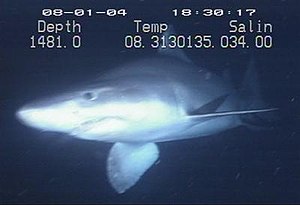Small-toothed sand tiger sharks
| Small-toothed sand tiger sharks | ||||||||||||
|---|---|---|---|---|---|---|---|---|---|---|---|---|

Shield tooth shark ( Odontaspis ferox ) |
||||||||||||
| Systematics | ||||||||||||
|
||||||||||||
| Scientific name of the family | ||||||||||||
| Odontaspididae | ||||||||||||
| Müller & Henle , 1839 | ||||||||||||
| Scientific name of the genus | ||||||||||||
| Odontaspis | ||||||||||||
| Agassiz , 1838 |
The small-toothed sand tiger sharks ( Odontaspis ) are a genus from the order of the mackerel shark-like (Lamniformes). It contains only two species , the smalltooth sand tiger ( Odontaspis ferox ) and bigeye sand tiger shark ( Odontaspis noronhai ). These are large species of shark with an average length of 3 meters, the maximum length can be over 4 meters.
features
The two species of the genus are large sharks with the typical streamlined shape of pelagic species. They reach an average body length of more than 3 meters, whereby the bigeye sand tiger shark can reach a maximum length of 3.60 and the shield tooth shark even 4.10 meters. The shield-toothed shark is gray to gray-brown in color and is often marked with spots, while the big-eyed sand tiger shark is much darker red-brown to black and unmarked.
Compared to the sand tiger shark ( Carcharias taurus ), they have a conical snout and comparatively large eyes. The first dorsal fin is also significantly larger than the second and the anal fin and it is much closer to the pectoral fins than to the pelvic fins. As with the sand tiger shark, the teeth are clearly visible when the mouth is closed, but they are smaller and less dense in the upper and lower jaw.
distribution
The two species of the genus occur worldwide in tropical marine areas, but are only known from a few isolated areas. In addition to the Atlantic, Pacific and Indian Oceans, the shield tooth shark is also found in the Mediterranean , while the bigeye sand tiger shark is only locally documented from some areas of the Atlantic and central Pacific.
The shield tooth shark lives in the area of the continental shelf at depths of up to 420 m, while the big-eyed sand tiger shark is a distinct deep-sea species with a distribution at depths between 600 and 1000 meters. Both live near the sea floor, but the former can also occur in higher open water layers and in the area of rocky coral reefs.
Way of life
Very little information is available about the way of life of the two species, especially that of the bigeye sand tiger shark. They are viviparous ( viviparous ), with the embryos feed in the womb of younger eggs and embryos. Both sharks feed on bony fish and invertebrates.
Systematics

The genus Odontaspis was introduced in 1838 by the Swiss-American naturalist Louis Agassiz . The type species is Odontaspis ferox . The genus belongs to the order of the mackerel shark-like (Lamniformes) and is placed there in the family Odontaspididae, to which the sand tiger shark ( Carcharias taurus ) also belonged until November 2019 .
As various studies on the mackerel shark systematics or cartilage fish systematics have shown, Odontaspis is not particularly closely related to the sand tiger shark. The closest relatives of Odontaspis are the thresher sharks (Alopiidae), the megamouth (Megachasmidae) and the crocodile shark (Pseudocarchariidae), while the sand tiger shark with the mackerel sharks (Lamnidae) and the basking (Cetorhinidae) a common clade forms within the Makrelenhaiartigen. In order to get back to monophyletic families, the Carchariidae family was revalidated in November 2019, which was introduced in 1838 by the German anatomists and zoologists Johannes Müller and Jakob Henle . The sand tiger shark is the only species of the Carchariidae, while only the genus Odontaspis remains among the Odontaspididae .
species
- Shield tooth shark ( Odontaspis ferox ( Risso , 1810) ),
- Bigeye sand tiger shark ( Odontaspis noronhai ( Maul , 1955) )
Danger
The shield tooth shark is listed as endangered ("vulnerable") in the Red List of the International Union for Conservation of Nature (IUCN), while there is insufficient data for a classification ("data deficient") for the bigeye sand tiger shark.
literature
- Leonard Compagno , Marc Dando, Sarah Fowler: Sharks of the World . Princeton Field Guides, Princeton University Press , Princeton and Oxford 2005; Pp. 176-177. ISBN 978-0-691-12072-0
supporting documents
- ↑ Odontaspis in the Catalog of Fishes (English)
- ↑ Deborah L. Bowden, Carolina Vargas-Caro, Jennifer R. Ovenden, Michael B. Bennett & Carlos Bustamante: The phylogenomic position of the gray nurse shark Carcharias taurus Rafinesque, 1810 (Lamniformes, Odontaspididae) inferred from the mitochondrial genome. Mitogenome Announcement, 2015, doi: 10.3109 / 19401736.2015.1089486
- ↑ Gavin JP Naylor, Janine N. Caira, Kirsten Jensen, Kerri AM Rosana, Nicolas Straube, Clemens Lakner: Elasmobranch Phylogeny: A Mitochondrial Estimate Based on 595 Species. Page 38 in Jeffrey C. Carrier, John A. Musick, Michael R. Heithaus: Biology of Sharks and Their Relatives (Marine Biology). Publisher: Crc Pr Inc, 2012, ISBN 1-4398-3924-7 . DOI: 10.1201 / b11867-4
- ↑ Kenshu Shimada: Phylogeny of lamniform sharks (Chondrichthyes: Elasmobranchii) and the contribution of dental characters to lamniform systematics. Paleontological Research, 9 (1): 55-72 (2005). doi: 10.2517 / prpsj.9.55
- ↑ Nicholas R. Stone and Kenshu Shimada: Skeletal Anatomy of the Bigeye Sand Tiger Shark, Odontaspis noronhai (Lamniformes: Odontaspididae), and Its Implications for Lamniform Phylogeny, Taxonomy, and Conservation Biology. Copeia 107 (4), 632-652, (2019). doi: 10.1643 / CG-18-160
Web links
- Small-toothed sand tiger sharks on Fishbase.org (English)
